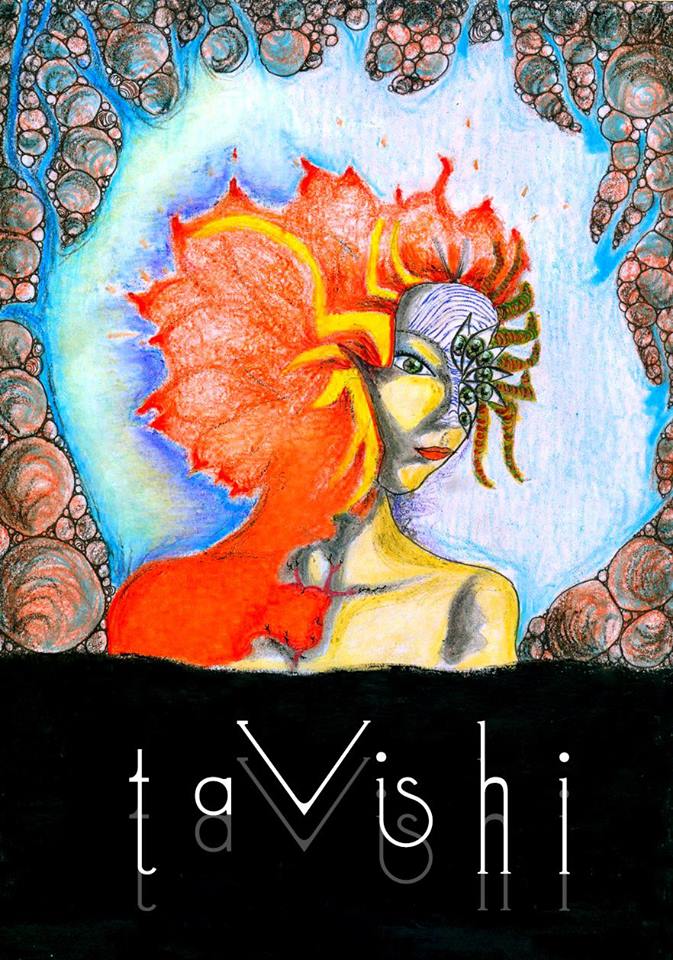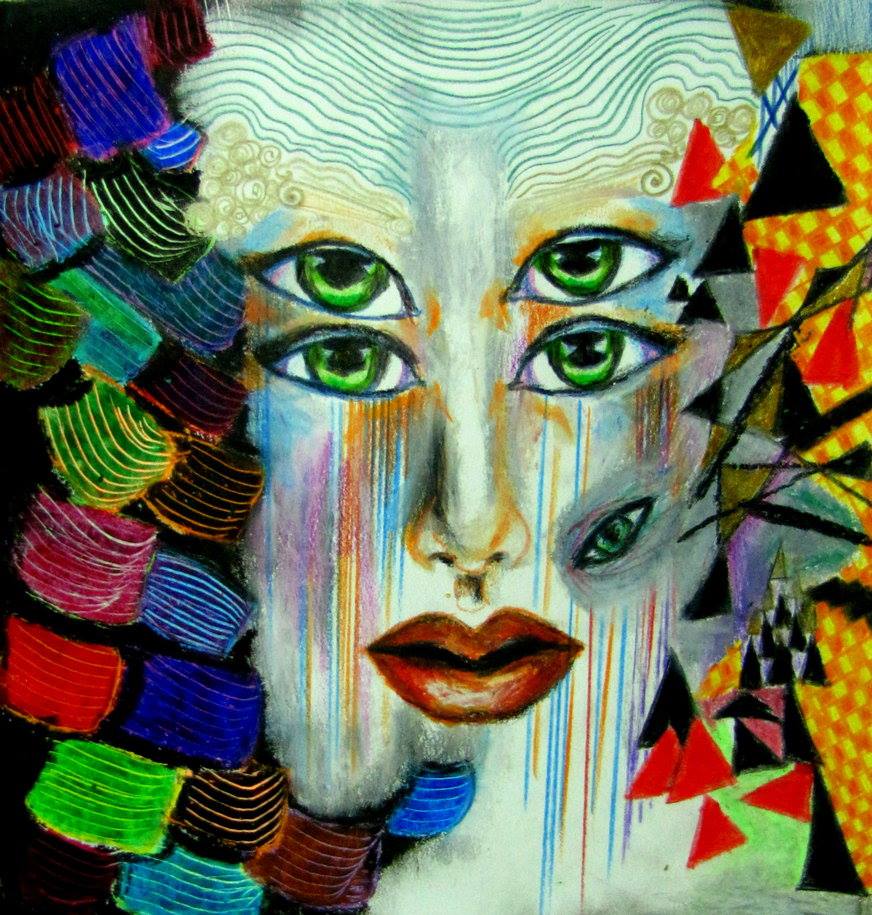মশ্তিষ্কের কণ্ঠশ্বর | Voices in my head
introducing the sound art and imagery of
Tavishi to the Open Horizons community
Getting to Know Tavishi
click on button for introduction to Tavishi by Lewis Gordon
Music is Never Just Music"Music is never just music for Sarmistha Talukdar. The Richmond-based non-binary artist, who has been performing as Tavishi since 2016, is neither content with only making aesthetically-pleasing sounds, nor does ze settle for making music that merely carries a message. Talukdar’s compositions—which oscillate between thunderous, fractured noise and sweet, pastoral ambience—might be best described as deeply personal activist sound art that’s entangled in both zir city’s flourishing DIY community (and their much-needed advocacy organizations) and wider, global systems of oppression." Eating Yourself as a Means of SurvivalTalukdar synthesizes zir mental monologue on the track “I eat myself alive” using a process of data sonification to convert amino acid sequences into cacophonous distortion; the abrasive textures hint at dark subject matter. “One of the things that [cancer cells] do is eat themselves during stressful conditions so that they can survive,” ze tells me. “When you’re surviving in a community that’s oppressed or oppressive, you’re constantly thinking, ‘Should I hide this aspect of myself?’ You’re silencing yourself so you can go through the motions of daily life. That’s a way of eating yourself, a means of survival.” |
Pulled in Contradicting Directions"Voices In My Head is Talukdar’s latest album and first release on Chinabot, the London-based label dedicated to highlighting emerging, experimental Asian music. The album’s title, ze tells me from a science lab at Virginia Commonwealth University, refers to an internal daily discourse that pulls Talukdar in seemingly contradicting directions. On the one hand, there’s zir day job as a cancer stem cell researcher. On the other is the India-born artist’s work as a musician, who draws on experimental noise, the raga traditions of Indian classical music, and Julianna Barwick-esque lullaby vocals to create almost impenetrably dense sound collages." Seeking Peace"In spite of everything—from intense, personal circumstances to what Talukdar perceives as the daily barrage of apocalyptic news--Voices In My Head ends on “Ether surrounds,” a tranquil, shimmering ambient track. With its softly wavering tones, the song is the aural equivalent of a cocoon, not only as a place of refuge but a space to grow. “It’s a resolution for the album,” ze says, smiling. “It’s about having a place where you belong. You might go through a lot of upheaval in your life, but hopefully you find a happier, peaceful situation in the end.” |
Sound Art by Tavishi
"Voices in My Head" and "Boundaries"
Boundaries |
|
"Voices in my head": An Interpretation
The album presents a yearning for relationships:
seeking a world beyond identity politics, gender binaries,
fear of 'immigrants', and the binary between humanity and nature
“Voices in my head” by Tavishi (Sarmistha Talukdar) presents a needed move, generally, for relationships. A collection of possible objects, a call to mobilize entanglements through collectivity, to enable instruments of change and disintegration, through instructions on listening, to encode and decode certain messages, through the programmability of possible objects. The compositions collected are artifacts for re-composing. Resisting the fixity of their recorded bases, resurrecting and transforming as models. They transmute the digital problematic of material world into humane impressions; the grand scale of the Anthropocene is enacted in small gestures. This seems to be in some way in line with the grand claims of that humanity is a prototype for a greater Creation, a biological mediation for synthetic technologies.
Mediating human identity politics, in traumas, experiences, is a double marginalization, woman and animal. Romanticism is deflated by the inherent exploitation in naturalism, gendering reason and emotions, feminizing nature. What is needed is a pledge of allegiance to no one, deconstructing the human form through substitutability, destabilizing hierarchies, even as entangled in the yearning for identity. Unsettling the positions, rejecting culture because of its abuse of nature destroys both culture and nature.
What happens when the history of the nature-culture binary ends? Humanity is already unequally distributed, and it can be imagined most critically as itself a kind of open wound. As in war, people are not spared. War brings particular ways of distinguishing natures through death."
So Where's the Spirituality?
it's in the listening for love's sake
We listen to voices inside our own heads, and we listen to voices inside other people’s heads, for love's sake. The voices we receive in the listening, and that the Soul itself redeives, are a potpourri of sounds, sometimes verbal and sometimes sonic, sometimes conflicted and sometimes complementary. We listen because we care about the people themselves and because we seek a world of positive relationships – a world of communities, each of which are creative, compassionate, participatory, diverse, inclusive, humane to animals, and good for the earth, with no one left behind. These communities are the building blocks of what we call “ecological civilizations.” They are not Anthropocene, as if the world must be humanized at the expense of other creatures and the earth, but rather Ecozoic. It is the well-being of all that we seek: human and more than human.
It is with these aspirations, then, that we listen to the sound art of Sarmistha Talukdar: Indian artist, scientist, photographer, and vocalist. We listen with our eyes as well as our ears, and most importantly with our hearts. Such listening may seem naïve to those involved in the harsh realities of identity politics and injustice. It may seem that what is most needed is not empathic listening but rather advocacy and protest in a spirit of pain and anger. And, of course, there is a powerful place for such advocacy and protest.
But the anger and protest must be grounded in a true understanding of what life-situation of other and, for that matter, in a true understanding of our own situation. This understand can only emerge if we cast way pre-conceived frameworks (binaries) and allow the complex entanglements of other people’s life, and our own, to weave their way into whatever wholes are possible, moment by moment. Tavishi’s “Voices in my head” is an occasion for just this kind of listening, after which, along with Tavishi, we seek to build the needed civilizations, community by community, for the sake of life and for the sake of Life, where no one is left behind.
It is with these aspirations, then, that we listen to the sound art of Sarmistha Talukdar: Indian artist, scientist, photographer, and vocalist. We listen with our eyes as well as our ears, and most importantly with our hearts. Such listening may seem naïve to those involved in the harsh realities of identity politics and injustice. It may seem that what is most needed is not empathic listening but rather advocacy and protest in a spirit of pain and anger. And, of course, there is a powerful place for such advocacy and protest.
But the anger and protest must be grounded in a true understanding of what life-situation of other and, for that matter, in a true understanding of our own situation. This understand can only emerge if we cast way pre-conceived frameworks (binaries) and allow the complex entanglements of other people’s life, and our own, to weave their way into whatever wholes are possible, moment by moment. Tavishi’s “Voices in my head” is an occasion for just this kind of listening, after which, along with Tavishi, we seek to build the needed civilizations, community by community, for the sake of life and for the sake of Life, where no one is left behind.





